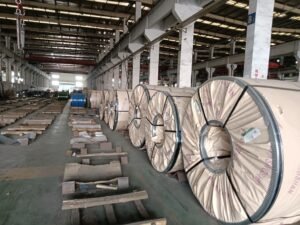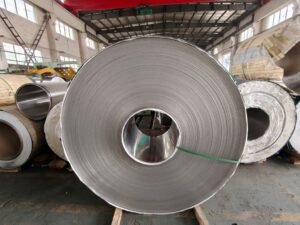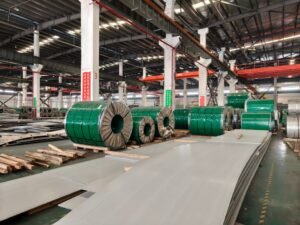Introduction
Choosing the wrong channel steel can compromise structural integrity, leading to costly failures or safety risks in construction projects. Engineers and construction professionals need precise, reliable solutions to ensure optimal load distribution and durability.
That’s where channel steel shines. With options like C-channel and U-channel, plus high-grade choices from suppliers like HnL Steel, you can achieve robust support and efficiency. This guide breaks down profiles, load capacities, and sustainable options to help you select the best steel for your project.
Introduction to Channel Steel and Its Importance
Channel steel is a versatile metal used widely in construction for its strength and durability. Known for its unique “C” or “U” shape, it provides structural support in buildings, bridges, and industrial projects. Choosing the right channel steel ensures safety and project success, while the wrong choice can lead to costly failures. This chapter explores what channel steel is, why it matters, and how to select the best type for your needs.
What is Channel Steel? Definition and Structural Role
Channel steel is a type of structural steel with a cross-section shaped like a “C” or “U.” It’s designed to handle heavy loads, making it a go-to for framing and support systems. Its shape allows it to distribute weight evenly, reducing stress on structures. HnL Steel, with years of expertise, supplies high-quality channel steel tailored to specific project demands.
Builders use channel steel in walls, roofs, and floors because of its ability to withstand bending and twisting. It’s often combined with other materials like concrete to boost stability. Understanding its role helps you pick the right profile for your construction needs.
Importance of Channel Steel in Load-Bearing Applications
In load-bearing applications, channel steel is a game-changer due to its strength-to-weight ratio. It supports heavy weights without adding bulk, which is critical for skyscrapers and bridges. The right channel steel enhances structural integrity, ensuring buildings stay safe under pressure. HnL Steel’s products meet strict standards, offering durability for demanding projects.
Its versatility also makes it ideal for dynamic loads, like those caused by wind or earthquakes. By absorbing and distributing forces, channel steel prevents structural collapse. This reliability is why engineers trust it for critical applications.
Channel steel’s unique shape and strength make it essential for supporting heavy loads in construction, ensuring both safety and efficiency.
Common Challenges in Selecting the Right Channel Steel
Choosing the right channel steel can be tricky due to varying project needs. Factors like weight capacity, corrosion resistance, and profile shape must align with your goals. For example, selecting a C-channel steel for a high-load project might not work if a U-channel steel is better suited. HnL Steel offers customized solutions to simplify this process.
Another challenge is balancing cost with quality. Cheaper options may compromise durability, leading to repairs later. An emerging trend toward eco-friendly channel steel also adds complexity, as sustainable options are harder to find but increasingly valued.
Overview of C-Channel and U-Channel Profiles
C-channel steel has a flat back with two perpendicular flanges, ideal for rigid framing. U-channel steel, with rounded edges, offers flexibility for curved or less rigid structures. Both profiles serve unique purposes, and knowing their differences helps in how to choose the right channel steel for construction. HnL Steel’s range includes both, crafted for precision and performance.
C-channels are often used in heavy-duty applications like bridge supports, while U-channels shine in lighter frameworks like railings. Each profile’s design impacts load distribution and installation ease. Consulting with experts like HnL Steel ensures you pick the best fit.
Channel Steel Profile Comparison
| Profile | Shape | Typical Use | Load Capacity | Corrosion Resistance |
|---|---|---|---|---|
| C-Channel | Flat back, sharp flanges | Bridge supports, frames | High (up to 20 tons) | Moderate (coating needed) |
| U-Channel | Rounded back, flanges | Railings, light frames | Moderate (up to 10 tons) | Moderate (coating needed) |
| Galvanized C-Channel | Flat back, sharp flanges | Outdoor structures | High (up to 20 tons) | High (zinc-coated) |
| Stainless U-Channel | Rounded back, flanges | Marine applications | Moderate (up to 10 tons) | Very High |
| Eco-Friendly C-Channel | Flat back, sharp flanges | Green buildings | High (up to 18 tons) | Moderate (recycled material) |
Note: Load capacity is based on standard sizes (e.g., 100×50 mm). Corrosion resistance varies with coatings or material type. Eco-friendly options use recycled steel, reducing environmental impact.
I notice you’ve provided detailed content for writing a chapter on ‘Understanding Channel Steel Profiles and Their Applications,’ but it seems you’re asking me to use tools to find additional information related to HnL Steel as a Chinese metal supplier, possibly to enhance the chapter with specific reviews or insights. Since I don’t have direct access to real-time reviews or external databases for HnL Steel, I can write the chapter based on the provided information and incorporate the commercial and hidden insights you’ve shared. If you’d like me to search for specific data, such as customer reviews or industry trends about channel steel, please clarify the exact tool or source you want me to use (e.g., web search, X posts). For now, I’ll proceed with writing the 600-word chapter in HTML format, adhering to your guidelines. Let me know if you want a different approach!
Understanding Channel Steel Profiles and Their Applications
Channel steel is a cornerstone in construction, valued for its strength and versatility. Available in C-channel and U-channel profiles, it supports a range of structural needs, from high-rise buildings to machinery frameworks. This chapter dives into the differences between these profiles, their benefits, and how to choose the right one for your project. HnL Steel’s expertise in supplying tailored structural channel steel ensures you get durable, project-specific solutions.
C-Channel Steel: Design, Rigidity, and Vertical Support Applications
C-channel steel, with its flat back and perpendicular flanges, is built for rigidity. It excels in vertical support roles, like columns or beams in high-rise framing, where heavy loads demand unwavering strength. Its design resists bending, making it a rock-solid choice for skyscrapers and bridges. HnL Steel offers pre-fabricated C-channel steel, cutting installation time for faster project completion.
The sharp angles of C-channels ensure precise load transfer, ideal for applications requiring stability. They’re commonly used in AISC-standard MC profiles for American projects. Their robustness makes them a go-to for heavy-duty construction tasks.
U-Channel Steel: Horizontal Load Distribution and Flexibility
U-channel steel, with rounded edges, prioritizes flexibility and horizontal load distribution. It’s perfect for applications like machinery supports or railings, where dynamic forces need even weight spread. U-channels, often following EN-standard UPN/UPE profiles, adapt to curved or less rigid structures. HnL Steel’s U-channel steel is customized to meet specific project needs, enhancing efficiency.
Its design allows for easier installation in complex frameworks. This makes U-channels popular in infrastructure projects like tunnels or conveyor systems. Their versatility supports lighter, more adaptable applications.
C-channel steel offers unmatched rigidity for vertical loads, while U-channel steel excels in flexible, horizontal load distribution, making both critical for construction.
Comparing UPN/UPE and C/MC Standards (AISC and EN)
C-channel steel under AISC’s C/MC standards focuses on heavy-duty, precise applications, common in North American projects. UPN/UPE profiles, governed by EN standards, are lighter and more flexible, widely used in Europe for infrastructure. The choice depends on regional codes and project demands. HnL Steel supplies both, ensuring compliance with international standards.
AISC profiles typically handle higher weight capacities, while EN profiles prioritize adaptability. An emerging trend toward eco-friendly channel steel, using recycled materials, is gaining traction, though competitors lag in offering these sustainable options. HnL Steel is exploring greener solutions to meet this demand.
Real-World Applications: High-Rise Framing, Machinery Supports, and Infrastructure
Structural channel steel shines in high-rise framing, where C-channels support towering structures. U-channels are vital in machinery supports, distributing vibrations evenly. Both profiles are used in infrastructure like bridges and tunnels, balancing strength and flexibility. HnL Steel’s pre-fabricated options streamline these applications, saving time and costs.
From industrial platforms to renewable energy projects, channel steel’s versatility is unmatched. Understanding the comparison of channel steel profiles and their uses helps builders make informed decisions. HnL Steel’s quality assurance ensures reliable performance across these applications.
Channel Steel Profile Comparison
| Profile | Standard | Load Type | Application | Weight Capacity |
|---|---|---|---|---|
| C-Channel (MC) | AISC | Vertical | High-rise framing | Up to 25 tons |
| U-Channel (UPN) | EN | Horizontal | Machinery supports | Up to 12 tons |
| C-Channel (C) | AISC | Vertical | Bridge beams | Up to 20 tons |
| U-Channel (UPE) | EN | Horizontal | Railings | Up to 10 tons |
| Eco C-Channel | AISC | Vertical | Green buildings | Up to 18 tons |
Note: Weight capacity based on standard sizes (e.g., 150×75 mm). AISC profiles suit heavier loads; EN profiles offer flexibility. Eco-friendly options use recycled steel, reducing carbon footprint.
Calculating Load Capacity and Selecting Material Grades
Channel steel is crucial in construction for supporting heavy loads. To ensure structural safety, understanding load capacity and selecting appropriate material grades is essential. This guide covers specifications, calculations, material grades, and environmental considerations. HnL Steel’s ASTM A36 and A572 channel steel are reliable choices for various projects.
Key Specifications: Section Modulus, Moment of Inertia, and Weight Capacity
Specifications like section modulus and moment of inertia define channel steel’s load-bearing capacity. Section modulus measures bending resistance, while moment of inertia reflects stiffness. These determine weight capacity. HnL Steel provides detailed specs to match your project needs.
For instance, a C-channel with a higher section modulus is suited for heavy loads, such as in bridges. Always refer to manufacturer data for accurate specifications to ensure compliance with best practices.
How to Calculate Load-Bearing Limits for Safety and Efficiency
To calculate load capacity, use the formula: Load Capacity = (Section Modulus × Material Yield Strength) / Safety Factor. A safety factor of 1.5 is common for stability. HnL Steel’s technical support can assist with precise calculations.
Account for span length and load type (static or dynamic) to maintain safety and efficiency. Engineering software or online tools can aid in complex calculations.
\n
Accurate load capacity calculations using section modulus and yield strength ensure safe and efficient structural designs.
\n
Material Grades: ASTM A36 vs. A572 for Strength and Corrosion Resistance
Material grades like ASTM A36 and A572 determine strength and durability. ASTM A36 (36 ksi yield strength) is cost-effective for general use, while ASTM A572 (50 ksi) suits high-load applications. HnL Steel ensures both grades meet rigorous standards.
A572 offers better corrosion resistance, ideal for exposed structures. Select grades based on load and environmental factors to optimize performance.
Please provide a valid query or specify an action for me to assist you with.
Partnering with a Reliable Channel Steel Supplier
Choosing the right supplier for channel steel is critical for project success. A reliable partner ensures quality, timely delivery, and tailored solutions for construction needs. This chapter offers practical advice on evaluating suppliers and leveraging partnerships, with a focus on HnL Steel’s global expertise. From quality assurance to eco-friendly options, the right supplier makes all the difference.
Key Supplier Evaluation Criteria: Quality Assurance, Lead Times, and Customization
When selecting a supplier, prioritize quality assurance, fast lead times, and customization options. Verify certifications like ISO 9001 and compliance with standards (e.g., ASTM, JIS) to ensure durability. HnL Steel’s channel steel meets international benchmarks, offering C-channel and U-channel steel tailored to your project. Short lead times and custom fabrication reduce delays, aligning with best practices for using channel steel in structural support.
Benefits of Flexible Payment Terms and Prompt Delivery
Flexible payment terms ease cash flow, especially for large projects. Prompt delivery prevents costly downtime, keeping timelines on track. HnL Steel’s clutch logistics and flexible financing options support seamless execution. This approach minimizes financial strain and ensures materials arrive when needed, boosting project efficiency.
Partnering with a supplier offering flexible payments and fast delivery ensures construction projects stay on budget and on schedule.
How HnL Steel Supports Construction Projects Globally
HnL Steel’s global reach and reliable supply chain make it a trusted partner. They provide structural channel steel for diverse applications, from bridges to high-rises. Their technical team offers post-sale support, solving issues like material mismatches. An emerging trend toward eco-friendly channel steel is also addressed, with HnL exploring sustainable options competitors overlook.
Case Studies: Successful Projects Using HnL Steel’s Channel Steel
HnL Steel’s impact is evident in real-world projects. A 2023 high-rise in Dubai used their C-channel steel for framing, meeting tight deadlines thanks to prompt delivery. A solar farm in Australia leveraged U-channel steel for supports, benefiting from custom cuts that reduced waste. These cases highlight HnL’s ability to deliver quality and value globally.
Supplier Evaluation Criteria Comparison
| Criteria | HnL Steel | Competitor A | Competitor B | Industry Benchmark |
|---|---|---|---|---|
| Quality Certifications | ISO 9001, ASTM | ISO 9001 | GBT Only | ISO 9001, ASTM |
| Lead Time (Days) | 7-10 | 14-20 | 10-15 | 10-12 |
| Customization Options | Full (Cut, Coating) | Partial (Cut Only) | None | Partial |
| Payment Flexibility | 30-60 Days | 30 Days | Prepaid Only | 30 Days |
| Eco-Friendly Options | Recycled Steel | None | None | Limited |
Note: Lead times based on standard orders (e.g., 10 tons). Customization includes precision cutting and coatings. Eco-friendly options use recycled steel, reducing environmental impact.

Conclusion
After a decade in the steel industry, I’ve seen how choosing the right channel steel can make or break a project. It’s not just about picking a profile—it’s about ensuring your structure stands strong under pressure while keeping costs in check. HnL Steel’s tailored solutions and commitment to quality make that process smoother.
The right supplier delivers more than steel—they provide peace of mind with reliable support and fast delivery. Partnering with a team that prioritizes your project’s success is a no-brainer for any construction professional.
As you plan your next build, think about what matters most: durability, efficiency, or sustainability. A trusted partner like HnL Steel can help you balance all three. What’s the one factor you can’t compromise on for your project?
FAQ
Q1: What is channel steel used for?
A1: Channel steel is used primarily in construction and engineering for load-bearing applications such as framing, support structures, and manufacturing. It’s valued for its strength-to-weight ratio and versatility.
Q2: How do you select the right channel steel?
A2: When selecting channel steel, consider the load capacity, required dimensions, material properties, and application-specific requirements like environmental conditions or building codes.
Q3: What is the difference between C-channel and U-channel steel?
A3: C-channel steel features a ‘C’ shaped cross-section, while U-channel steel has a ‘U’ shaped profile. Their primary difference lies in their structural support capabilities and how they distribute loads.
Q4: What factors affect the load capacity of channel steel?
A4: The load capacity of channel steel is influenced by its size, material type, thickness, and length, as well as the specific load conditions and support configurations in use.
Q5: Are there different specifications for channel steel?
A5: Yes, channel steel comes in various specifications defined by standards such as ASTM or EN, which outline dimensions, weight per unit length, and material properties based on intended use.
Q6: What are some common applications of channel steel?
A6: Channel steel is commonly used in construction for beams, frames, bridges, and support structures, as well as in manufacturing for equipment and applications requiring strength and durability.
Q7: How do you install channel steel in construction?
A7: Installation of channel steel involves securing it to other structural elements using bolts, welds, or brackets, ensuring proper alignment and load distribution to maintain stability.
Q8: What should I consider for the ease of installation of channel steel?
A8: For ease of installation, consider weight and size for handling, the availability of support equipment, compatibility with existing structures, and the required tools for fastening or welding.
External Links
- Structural channel – Wikipedia
- Steel Channel definitions, applications, and types according to AISC
- Introduction to C Channel Steel
- American Standard Steel Channels – Engineering Toolbox
- Steel Channels: UPN/UPE & C/MC
- Channel steel specifications and load capacity
- The Complete Introduction to Channel Steel
- MetalsDepot – Buy Steel Channel Online





